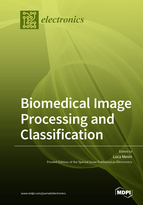Biomedical Image Processing and Classification
A special issue of Electronics (ISSN 2079-9292). This special issue belongs to the section "Computer Science & Engineering".
Deadline for manuscript submissions: closed (15 September 2020) | Viewed by 29503
Special Issue Editor
Interests: biomedical signal and image processing and classification; biophysical modelling; clinical studies; mathematical biology and physiology; noninvasive monitoring of the volemic status of patients; nonlinear biomedical signal processing; optimal non-uniform down-sampling; systems for human–machine interaction
Special Issues, Collections and Topics in MDPI journals
Special Issue Information
Dear Colleagues,
Biomedical image processing is an interdisciplinary field that spreads its foundations throughout a variety of disciplines, including electronic engineering, computer science, physics, mathematics, physiology, and medicine. Several imaging techniques have been developed, providing many approaches to the study of the body, including X-rays for computed tomography, ultrasounds, magnetic resonance, radioactive pharmaceuticals used in nuclear medicine (for positron emission tomography and single-photon emission computed tomography), elastography, functional near-infrared spectroscopy, endoscopy, photoacoustic imaging, and thermography. Even bioelectric sensors, when using high-density systems (e.g., in electroencephalography or electromyography), can provide maps that can be studied with image processing methods. Biomedical image processing is finding an increasing number of important applications, for example, to study the internal structure or function of an organ and in the diagnosis or treatment of a disease. If associated with classification methods, it can support the development of computer-aided diagnosis (CAD) systems, e.g., for the identification of a diseased tissue or a specific lesion or malformation.
The aim of this Special Issue is to collect high-quality works that document a wide range of image processing applications to biomedical problems. Topics of interest include (but are not limited to) image enhancement, registration, segmentation, restoration, compression, and movement tracking, with the aim of identifying tissue properties or the pathology of a patient.
Prof. Dr. Luca Mesin
Guest Editor
Manuscript Submission Information
Manuscripts should be submitted online at www.mdpi.com by registering and logging in to this website. Once you are registered, click here to go to the submission form. Manuscripts can be submitted until the deadline. All submissions that pass pre-check are peer-reviewed. Accepted papers will be published continuously in the journal (as soon as accepted) and will be listed together on the special issue website. Research articles, review articles as well as short communications are invited. For planned papers, a title and short abstract (about 100 words) can be sent to the Editorial Office for announcement on this website.
Submitted manuscripts should not have been published previously, nor be under consideration for publication elsewhere (except conference proceedings papers). All manuscripts are thoroughly refereed through a single-blind peer-review process. A guide for authors and other relevant information for submission of manuscripts is available on the Instructions for Authors page. Electronics is an international peer-reviewed open access semimonthly journal published by MDPI.
Please visit the Instructions for Authors page before submitting a manuscript. The Article Processing Charge (APC) for publication in this open access journal is 2400 CHF (Swiss Francs). Submitted papers should be well formatted and use good English. Authors may use MDPI's English editing service prior to publication or during author revisions.
Keywords
- Image registration
- Image segmentation
- Motion tracking
- Computer-added diagnosis
- Deep learning
- Machine learning and classification
- Patient-specific diagnosis






